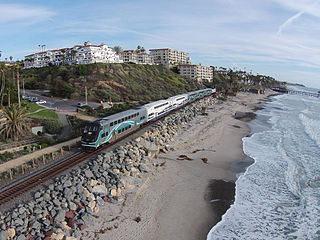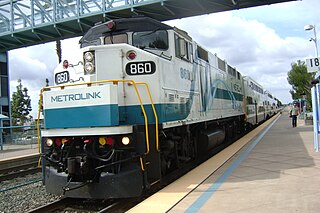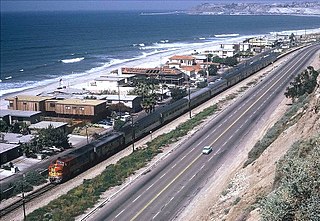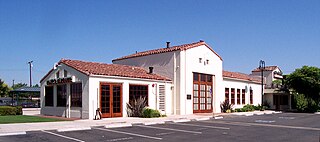
Orange County, often known by its initials O.C., is a county located in the Los Angeles metropolitan area in Southern California, United States. As of the 2020 census, the population was 3,186,989, making it the third-most-populous county in California, the sixth-most-populous in the United States, and more populous than 19 American states and Washington, D.C. Although largely suburban, it is the second-most-densely-populated county in the state behind San Francisco County. The county's three most-populous cities are Anaheim, Santa Ana, and Irvine, each of which has a population exceeding 300,000. Santa Ana is also the county seat. Six cities in Orange County are on the Pacific coast: Seal Beach, Huntington Beach, Newport Beach, Laguna Beach, Dana Point, and San Clemente.

The Los Angeles County Metropolitan Transportation Authority (LACMTA), branded as Metro, is the county agency that plans, operates, and coordinates funding for most of the public transportation system in Los Angeles County, California, the most populated county in the United States.

State Route 91 (SR 91) is a major east–west state highway in the U.S. state of California that serves several regions of the Greater Los Angeles urban area. A freeway throughout its entire length, it officially runs from Vermont Avenue in Gardena, just west of the junction with the Harbor Freeway, east to Riverside at the junction with the Pomona and Moreno Valley freeways.

State Route 55 (SR 55) is an 18-mile (30-km) long north–south state highway that passes through suburban Orange County in the U.S. state of California. The portion of the route built to freeway standards is known as the Costa Mesa Freeway. SR 55 runs between Via Lido south of Pacific Coast Highway in Newport Beach and the Riverside Freeway in Anaheim to the north, intersecting other major Orange County freeways such as SR 22, SR 73, and Interstate 405 (I-405).

Metrolink is a commuter rail system in Southern California, serving Los Angeles, Orange, Riverside, San Bernardino, and Ventura counties, as well as to Oceanside in San Diego County. The system consists of eight lines and 69 stations operating on 545.6 miles (878.1 km) of track. Arrow is operated under a contract with the San Bernardino County Transportation Authority (SBCTA).

The Southern California freeways are a vast network of interconnected freeways in the megaregion of Southern California, serving a population of 23 million people. The Master Plan of Metropolitan Los Angeles Freeways was adopted by the Regional Planning Commission in 1947 and construction began in the early 1950s. The plan hit opposition and funding limitations in the 1970s, and by 2004, only some 61% of the original planned network had been completed.

The Orange County Line is a commuter rail line run by Metrolink from Los Angeles through Orange County to Oceanside in San Diego County, connecting with the Coaster commuter rail service to San Diego. The Orange County Line carries passengers to the primary Metrolink hub at L.A. Union Station in downtown Los Angeles, as well as to many attractions in Orange County including the Knott's Berry Farm area, Angel Stadium of Anaheim and the Honda Center, the Disneyland Resort, Old Town Orange, Santa Ana Zoo, Mission San Juan Capistrano and many more. In San Diego County, it serves the Oceanside Pier and Camp Pendelton.

The Surf Line is a railroad line that runs from San Diego north to Orange County along California's Pacific Coast. It was so named because much of the line is near the Pacific Ocean, within less than 100 feet (30 m) in some places. The tracks are now owned by the Orange County Transportation Authority and the North County Transit District, and hosts Metrolink's Orange County Line and Inland Empire–Orange County Line, the San Diego Coaster, and Amtrak Pacific Surfliner passenger trains. The BNSF Railway operates freight over the line using trackage rights.

The Santa Ana Regional Transportation Center is a passenger rail station and transportation center in Santa Ana, California. It is used by Amtrak's Pacific Surfliner and Metrolink's Orange County Line and Inland Empire–Orange County Line trains. It is also a Greyhound station and a hub for the Orange County Transportation Authority bus system as well as a terminal for international bus services to Mexico.

The Irvine Transportation Center is a passenger rail and bus terminal in the Irvine Spectrum district of southeastern Irvine, California, United States. Located on the southwest end of the decommissioned Marine Corps Air Station El Toro, it is served by Amtrak California's Pacific Surfliner route, two Metrolink commuter rail lines, and multiple Orange County Transportation Authority bus routes.

Orange station, formally the Orange Transportation Center, is an intermodal transit station in Orange, California. It serves Metrolink trains as well as Orange County Transportation Authority buses. The station is located at the site of two former Atchison, Topeka and Santa Fe Railway combination depots. The present depot structure was dedicated on May 1, 1938, and was closed with the Santa Fe's discontinuation of passenger service in 1971. The building was granted historic landmark status by the City on November 15, 1990.

Buena Park station is a train station in Buena Park, California, United States, served by Metrolink commuter rail. It is at the center of a transit-oriented development including townhomes and a housing complex owned by the California State University, Fullerton, near the corner of Dale Street and Malvern Avenue. The station is served by Metrolink's Orange County Line and 91/Perris Valley Line.

Harbor Boulevard is a north–south road corridor in the counties of Los Angeles and Orange. One of the busiest routes in Orange County, the thoroughfare passes through some of the most densely populated areas in the region and carries about 8 percent of the county's bus riders. The route provides access for local residents to travel to work and for drivers travelling from Valley Boulevard in the City of Industry via Fullerton Road to Newport Beach.

Greater Los Angeles has a complex multimodal transportation infrastructure, which serves as a regional, national and international hub for passenger and freight traffic. The transportation system of Greater Los Angeles includes the United States' largest port complex, seven commuter rail lines, Amtrak service, a subway system within the city of Los Angeles, and numerous highways. Los Angeles is integrated into the Interstate Highway System by Interstate 5, Interstate 10, and Interstate 15, along with numerous auxiliary highways and state routes. Bus service is also included locally within the area by numerous local government agencies. Subways and light commuter rail lines are present within Los Angeles proper, allowing mass transportation within the city. Commuter railroads are run by Metrolink. Amtrak has numerous railroad lines that connect Los Angeles to the rest of the country.

The Anaheim Regional Transportation Intermodal Center (ARTIC) is an intermodal transit center in Anaheim, California, United States. It serves as a train station for Amtrak intercity rail and Metrolink commuter rail, as well as a bus station used by the Orange County Transportation Authority (OCTA), Anaheim Resort Transportation (ART), Greyhound, Megabus, Flixbus and Tres Estrellas de Oro.
Measure R was a ballot measure during the November 2008 elections in Los Angeles County, California, that proposed a half-cent sales taxes increase on each dollar of taxable sales for thirty years in order to pay for transportation projects and improvements. The measure was approved by voters with 67.22% of the vote, just over the two-thirds majority required by the state of California to raise local taxes. The project was touted as a way to "improve the environment by getting more Angelenos out of their cars and into the region's growing subway, light rail, and bus services." It will result in the construction or expansion of a dozen rail lines in the county.

The West Santa Ana Branch is a rail right-of-way formerly used by the Pacific Electric's (PE) Santa Ana route in Los Angeles County and Orange County in Southern California. The Los Angeles County Metropolitan Transportation Authority (Metro) owns the segment of the right-of-way in Los Angeles County, and the Orange County Transportation Authority (OCTA) owns the segment in Orange County.

OC Bus is the transit bus service operated by the Orange County Transportation Authority (OCTA), serving every city in Orange County. Some of the lines serve the Los Angeles County border communities of Lakewood, La Mirada, Cerritos, Hawaiian Gardens, and Long Beach. As of February 2023, there are 52 routes in the system.
The OC Streetcar is a modern streetcar line currently under construction in Orange County, California, running through the cities of Santa Ana and Garden Grove. The electric-powered streetcar will be operated by the Orange County Transportation Authority (OCTA), and will serve ten stops in each direction along its 4.15-mile (6.68 km) route. With the exception of a short loop in downtown Santa Ana, the line will be double-tracked for its entire length. Most of the route follows the original path of the Pacific Electric Railway "Red Cars" that served Santa Ana in the early 20th century, before being abandoned in 1950. Construction on the streetcar broke ground on November 30, 2018. As of October 2023, the line's expected revenue service date has been pushed to August 2025, per OCTA staff, despite initial plans for a 2021 start.

Anaheim Rapid Connection (ARC) was a proposed streetcar line in Anaheim, California. It would have been located in the Anaheim Resort and Platinum Triangle, with stops at the Disneyland Resort, the Anaheim Convention Center, and the Anaheim Regional Transportation Intermodal Center (ARTIC), among others. It has been the subject of much political controversy, which led to the project being cancelled by OCTA in 2018. Councilmembers from the cities of Anaheim and Fullerton stated opposition to the streetcar mode citing concerns about traffic impacts, safety, capital costs, and recent declining transit ridership. These cities also shared concerns about how implementation of dedicated transit lanes would impact automobile traffic.





















